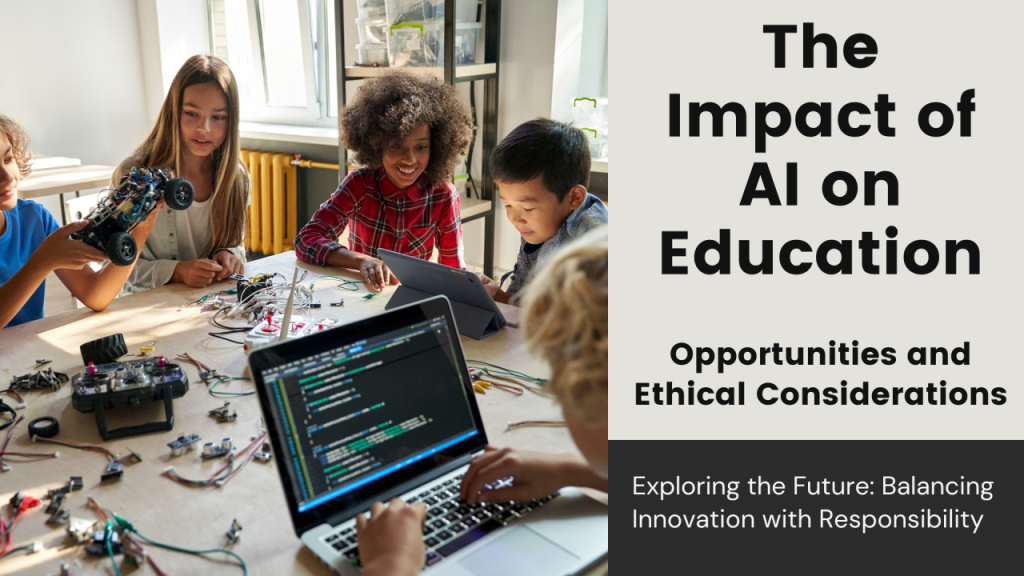The Future of Artificial Intelligence in Education: Opportunities and Ethical Considerations

The AI Revolution in Educational Technology
The educational landscape is experiencing a profound transformation driven by artificial intelligence and related **tech**nologies. From intelligent tutoring systems to automated administrative processes, AI is reshaping how educational institutions operate and how learning experiences are designed and delivered. This revolution extends beyond simple automation of existing practices to enable entirely new approaches to teaching and learning that were previously impossible. Adaptive learning platforms can now analyze student performance in real-time, adjusting content and pacing to meet individual needs. Natural language processing allows for more sophisticated interactions between students and digital learning environments. Computer vision applications enable new forms of assessment and feedback. Together, these AI capabilities are creating unprecedented opportunities for personalized, effective, and engaging education at scale.
Current Applications of AI in Education
Personalized Learning Environments
AI-powered personalized learning environments represent one of the most promising applications of this technology in education. These systems collect and analyze data about student performance, preferences, and behaviors to create customized learning pathways. Unlike traditional “one-size-fits-all” approaches, AI-enabled personalization can adapt in real-time to student needs, providing additional practice in areas of difficulty and accelerating progress where students demonstrate mastery. The most sophisticated systems incorporate multiple data sources and learning theories to create holistic personalization strategies that address not just academic content but also learning modalities, pace, and context.
The evolving relationship between teachers and AI technologies represents a critical dimension of educational transformation. Rather than replacing human educators, the most successful AI implementations augment teacher capabilities by handling routine tasks, providing actionable insights from educational data, and enabling more differentiated instruction. This complementary relationship allows teachers to focus their time and expertise on high-value activities such as building relationships, providing emotional support, fostering critical thinking, and guiding complex learning processes. The teacher-AI partnership represents a powerful combination of human and machine capabilities that can enhance educational outcomes when thoughtfully designed and implemented.
Emerging AI Capabilities and Educational Applications
Multimodal Learning Analytics
The next generation of AI in education is moving beyond text-based analysis to incorporate multimodal data sources including speech, facial expressions, gestures, and physical movements. These advanced analytics systems can provide insights into dimensions of learning that were previously difficult to measure, such as student engagement, emotional states, and collaborative processes. When implemented responsibly with appropriate privacy safeguards, multimodal learning analytics offer unprecedented opportunities to understand and support the full spectrum of learning experiences.
AI-Enabled Content Creation
Artificial intelligence is increasingly being used to generate and curate educational content, from personalized practice problems to comprehensive learning materials adapted for different contexts and needs. These systems can analyze curriculum standards, student data, and pedagogical best practices to create resources that align with specific learning objectives and student characteristics. While human oversight remains essential for ensuring quality and appropriateness, AI content generation tools can significantly reduce the time and effort required to develop differentiated educational materials.
Ethical Considerations and Challenges
Privacy and Data Security
The extensive data collection required for effective AI applications in education raises significant privacy concerns that must be carefully addressed. Educational institutions must develop comprehensive data governance frameworks that clearly define what information is collected, how it is used, who has access to it, and how long it is retained. Transparent communication with students, families, and educators about these practices is essential for building trust and ensuring informed consent. Additionally, robust technical security measures must be implemented to protect sensitive educational data from unauthorized access or breaches.
Algorithmic Bias and Fairness
AI systems reflect the data and assumptions used in their development, potentially perpetuating or amplifying existing biases in educational assessment and resource allocation. Addressing this challenge requires multifaceted approaches including diverse development teams, representative training data, explicit fairness metrics, regular bias audits, and meaningful human oversight. Educational institutions must critically evaluate AI systems for potential biases before implementation and continuously monitor their impact on different student populations, particularly those historically underserved by educational systems.
Transparency and Explainability
The “black box” nature of many AI systems presents significant challenges in educational contexts where understanding the rationale behind decisions and recommendations is crucial for both pedagogical effectiveness and institutional accountability. Developing more explainable AI approaches for education involves creating systems that can communicate their reasoning in terms understandable to educators, students, and families. This transparency is essential for allowing stakeholders to evaluate the appropriateness of AI-driven recommendations and maintain appropriate human judgment in educational decision-making.
Implementing AI in Educational Systems
Policy and Governance Frameworks
Effective implementation of AI in education requires thoughtful policy and governance frameworks at multiple levels. Institutional policies should address issues such as data management, algorithm procurement and evaluation, stakeholder involvement, and ongoing monitoring. National and international guidelines can provide broader normative frameworks while allowing for contextual adaptation. These governance structures should be designed to balance innovation and protection, enabling beneficial AI applications while safeguarding student interests and educational values.
Professional Development for Educators
For AI to fulfill its potential in education, teachers need specialized professional development that goes beyond basic technical skills to include AI literacy, data interpretation, and pedagogical integration. Effective professional learning approaches in this area combine theoretical understanding with practical application, helping educators develop both conceptual knowledge about AI systems and concrete strategies for incorporating them into their teaching practice. This professional development should be ongoing and adaptive, evolving alongside the technologies themselves.
Future Scenarios and Considerations
Human-AI Complementarity
The most promising future for AI in education lies not in automation that replaces human elements but in thoughtful integration that enhances human capabilities and relationships. This complementary approach recognizes the unique strengths of both AI systems (processing vast amounts of data, identifying patterns, performing routine tasks) and human educators (emotional intelligence, ethical judgment, creative thinking, cultural responsiveness). Designing educational experiences that leverage these complementary strengths requires intentional focus on the appropriate role of technology in different aspects of the learning process.
Equity and Access Considerations
As AI becomes increasingly integrated into educational systems, ensuring equitable access and benefit becomes a critical concern. Without deliberate attention to equity issues, AI technologies risk exacerbating existing educational disparities along lines of socioeconomic status, geography, language, disability status, and other factors. Addressing this challenge requires multifaceted approaches including infrastructure investment, culturally responsive design, multilingual development, disability inclusion, and proactive monitoring of differential impacts across student populations.
International Perspectives and Approaches
Cultural Variations in AI Adoption
The implementation of AI in education varies significantly across different cultural and national contexts, reflecting diverse educational philosophies, regulatory environments, and societal values. Some regions prioritize efficiency and standardization through AI automation, while others emphasize human-AI collaboration and creativity. Understanding these variations is essential for developing culturally appropriate AI educational solutions and facilitating meaningful international collaboration in this field.
Global Standards and Cooperation
As educational AI becomes increasingly globalized, international cooperation on standards and best practices becomes more important. Collaborative efforts across borders can address shared challenges such as data interoperability, ethical frameworks, and quality benchmarks. These cooperative initiatives should acknowledge legitimate cultural differences while establishing core principles for responsible AI use in education that transcend national boundaries.
Preparing Students for an AI-Transformed World
AI Literacy as an Educational Priority
Beyond using AI tools in education, schools must prepare students to understand and engage with artificial intelligence as citizens and professionals in an AI-transformed society. Comprehensive AI literacy education includes technical components (understanding how AI systems function), practical aspects (using AI tools effectively), and critical dimensions (evaluating AI applications ethically). This multifaceted approach helps students develop the knowledge and skills needed to participate meaningfully in shaping how AI technologies are developed and deployed in society.
Developing “AI-Proof” Skills
As artificial intelligence automates an increasing range of tasks, education must emphasize developing distinctively human capabilities that complement rather than compete with AI systems. These “AI-proof” skills include creative thinking, ethical reasoning, interpersonal communication, emotional intelligence, and complex problem-solving. By focusing on these areas, educational institutions can help prepare students for a future where human-AI collaboration becomes the dominant paradigm across most professional fields.
Research Directions in AI and Education
Evidence-Based Implementation
The rapid development of educational AI technologies has sometimes outpaced research on their effectiveness and impact. Strengthening the evidence base for AI in education requires rigorous studies that move beyond short-term technical evaluations to examine broader educational outcomes across diverse contexts. This research should employ mixed methods approaches that combine quantitative measures of learning gains with qualitative insights into student and teacher experiences. Building this evidence base is essential for making informed decisions about which AI applications truly advance educational goals.
Interdisciplinary Collaboration
Addressing the complex challenges and opportunities of AI in education requires collaboration across multiple disciplines including education, computer science, psychology, ethics, sociology, and policy studies. These interdisciplinary efforts can help bridge gaps between technical possibilities and educational needs, ensuring that AI development is guided by sound learning theories and pedagogical principles. Creating institutional structures that support and incentivize such collaboration is an important step toward more effective educational AI applications.
Conclusion: Shaping the Future of AI in Education
The integration of artificial intelligence in education presents both tremendous opportunities and significant challenges for educational systems worldwide. By approaching this technological transformation with thoughtful attention to ethical considerations, equity implications, and the irreplaceable human dimensions of education, we can harness AI’s potential while preserving and enhancing the core values of educational practice. The future of AI in education should not be determined by technological capabilities alone, but by deliberate choices that align these capabilities with our broader educational and societal goals. Through collaborative efforts across disciplines, sectors, and borders, we can work toward AI applications that genuinely enhance teaching and learning for all students.






